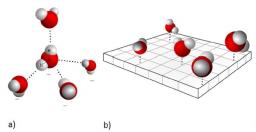Laboratoire Léon Brillouin
UMR12 CEA-CNRS, Bât. 563 CEA Saclay
91191 Gif sur Yvette Cedex, France
+33-169085241 llb-sec@cea.fr
Laboratoire Léon Brillouin
UMR12 CEA-CNRS, Bât. 563 CEA Saclay
91191 Gif sur Yvette Cedex, France
+33-169085241 llb-sec@cea.fr

(a) In bulk liquid water, a molecule is connected by HBonds (dotted lines) to an average of slightly less than four molecules. (b) In this paper, water is adsorbed as a monolayer (6 wt%) onto the surface of Vycor. This sketch is a realistic graphical representation of
the microscopic structure of the 2D-water.
The properties of bulk water come from a delicate balance of interactions on length scales encompassing several orders of magnitudes: i) the Hydrogen Bond (HBond) at the molecular scale and ii) the extension of this HBond network up to the macroscopic level. Here, we address the physics of water when the three dimensional extension of the HBond network is frustrated, so that the water molecules are forced to organize in only two dimensions. We account for the large scale fluctuating HBond network by an analytical mean-field percolation model. This approach provides a coherent interpretation of the different events experimentally (calorimetry, neutron, NMR, near and far infra-red spectroscopies) detected in interfacial water at 160, 220 and 250 K. Starting from an amorphous state of water at low temperature, these transitions are respectively interpreted as the onset of creation of transient low density patches of 4-HBonded molecules at 160 K, the percolation of these domains at 220 K and finally the total invasion of the surface by them at 250 K. The source of this surprising behaviour in 2D is the frustration of the natural bulk tetrahedral local geometry and the underlying very significant increase in entropy of the interfacial water molecules.
